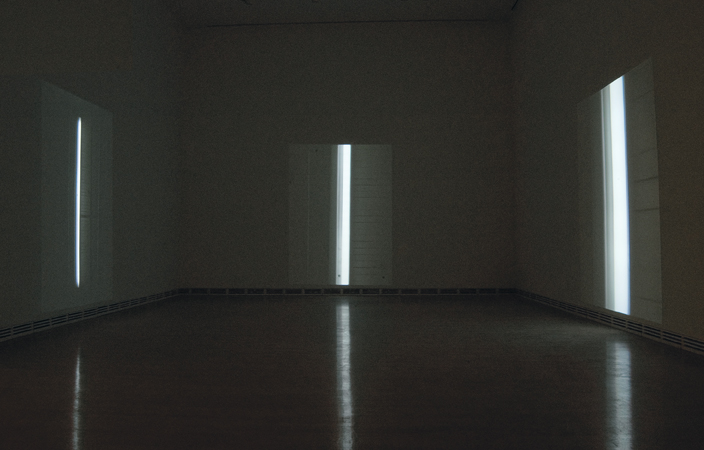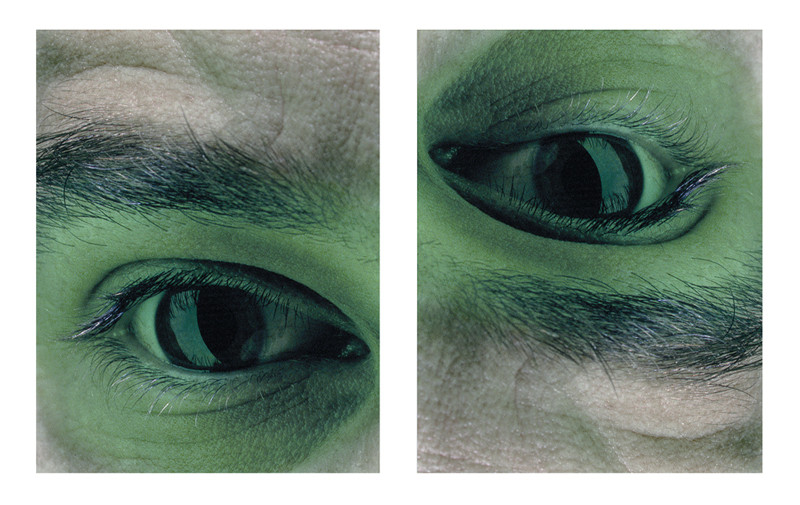[Summer 2008]
Carleton University Art Gallery, Ottawa
January 14 – April 13, 2008
A rupture occurs when an action is played out in its conventional sequence and then witnessed in reverse. The action’s asynchronous interconnection serves as a narrative and visual conceit; time runs forwards and backwards in a rearward déjà vu. In static form, this temporal reversal takes the form of doubling: mirror images, inversions, and stop-action photographs. While the corresponding actions bear the traces of their former views, they exist interdependently as echoes of one another. Captured for contemplation, gestures shown overturning themselves jostle the viewer out of what might otherwise be a passive place of looking. They allow the entire action to be perceived more closely, not only because what is depicted is experienced with a layered awareness of the recently transpired precursor, but also because the chain of events or images, running contrary to what can be witnessed in life, is unsettling. The artificial nature of the visual pause is precisely what breathes new life into commonplace occurrences, thereby uncovering their poetry.
Best known for his large-scale images that blur boundaries between portraiture, advertising, and documentary, Pascal Grandmaison has garnered an international reputation with steady confidence. The exhibition Le grand jour, on view at the Carleton University Art Gallery, features a video installation and five new works by the artist, each employing a reversal or mirroring of action as a means to reconsider not only the architectural constraints and freedoms of photography and film as media for narrative, but also the overarching societal and economic constructions of the lived environment.
The exhibition draws its title from an installation composed of three large projections, presenting progressive close-ups of a fluorescent light fixture in the corridor of the artist’s studio. By showing the object at a monumental scale and placing the images on a vertical axis, Grandmaison makes a nod to Dan Flavin and creates his own space for the viewer to ponder a completely mundane and altogether omnipresent object – overhead illumination that one tends to ignore rather than contemplate. The views, subtitled “morning,” “noon,” and “evening,” successively close in on the gas moving inside the tube and then appearing to reverse on itself. This little action underscores the hypnotic capability of the everyday and its capacity for transformation.
I See You in Reverse (2008) is a super-16 mm film (transferred to DVD), in which the viewer encounters the thirty-third floor of one of the Toronto Dominion Centre towers, designed by Mies Van Der Rohe, an architect synonymous with the logic and order wrestled from chaotic tenets of modernism. In the looped sequence, the building is midway between demolition and renovation and strangely at rest; the soundtrack is a recording of off-site construction sounds played backward. The viewer takes in the space and the exterior views of urban sky through the windows while watching a young woman slowly cross the expanse. She travels the distance impassively, and yet her slow, gliding movements bear the elegant pacing of choreography. The reversal in the film is likewise lyrical – a puff of smoky cloud rolls backward in the skyline, and with it the movements unfold anew.
No Black Light (2007) is a suite of fourteen colour photographs; each image chronicles a part of the slow rotation of a piece of glass, corresponding in scale to a window in the Mies Van Der Rohe building depicted in I See You in Reverse. For this work, Grandmaison uses a process known as “chroma key,” commonly known as “bluescreen” or “greenscreen.” This filmmaking technique was the precursor to digital compositing. The background scene is shot first and the actors are filmed later, playing out the actions in front of a screen painted blue or green. The sequences are then fused together using filters that create two mattes, each a reverse silhouette of the other. For No Black Light (2007), Grandmaison painted glass with green paint so that it disappears on the paper, leaving only a black space. These luminous silhouettes, reminiscent of abstract paintings such as Malevich’s Black Square, acknowledge the cinematic heritage of crafting scenes together by hand, as well as calling to mind its forerunners in early photographic history, such as contact printing with glass plates.
The pair of reversed images titled Hoping the Light Will Save Us 1 (2008) celebrates photography’s ability to make the implausible – balancing a meteor rock on the back of your hand – entirely believable, through the use of stop action. In a parallel diptych, Hoping the Light Will Save Us 2 (2008), an extreme close-up pairing of inverted eyes stare blankly out into the room. In both sets of photographs, a sickly green glow illuminates the subject’s flesh, calling to mind the narrative convention in graphic novels of the hero’s transformation sequence. The light, proposed in the titles as a kind of salvation, inevitably comes with a price – superheroes must ultimately hide their powers and they rarely reveal their true selves without suffering the consequences.
Le grand jour takes square aim at the history, conceits, and tenets of storytelling in film and photography, while offering commentary on the construction of the lived environment and the everyday. Filtered through the lens of an analytical rewind, Grandmaison’s perceptions offer exciting promises of what lies ahead in his burgeoning career.
Galerie René Blouin, Montréal
1 March – 12 April 2008
In Michelangelo Antonioni’s iconic 1966 film Blowup, a photographer thinks that he has captured the evidence of a murder. He obsessively makes enlargement after enlargement, hoping to piece together what might have transpired. The magnified image serves as a metaphor for perception and reality; things change as they viewed and reviewed.
With five new works presented at Galerie René Blouin, Pascal Grandmaison offers the viewer his own series of “blowups.” The four pairings in the main gallery individually and collectively function as meditations on the sum of the parts of photography and cinema – lenses, views, flashes, and paper – and on the inherent complexities of references and signification.
The dates figuring in the titles of Background I: 1912–2007 and Background II 1912–2007 (2008) acknowledge Antonioni’s lifespan; the extreme close-ups of crumpled paper refer to his use of the dead time, a cinematic trope in which the viewer’s attention is drawn to the evidence of an action that occurred outside of the narrative space. It is this aftermath that creates dramatic tension, as the viewer must infer the event rather than watch it revealed.
In a small space adjacent to the main room, Grandmaison’s piece titled Increasingly Empty Forms 1928–1999 (2008), composed of twelve digital chromogenic prints mounted on Plexiglas, alludes to the life and work of another filmmaker, Stanley Kubrick. Like Antonioni’s films, Kubrick’s work bears hallmarks of his signature: extreme close-ups generating dramatic tension. For his part, Grandmaison uses the close-ups of Kubrick’s biography to stress that images can’t tell the whole story. They do, however, exert their hold on to the viewer by teasing out arresting moments for contemplation that become impossible to shake out of the imagination.
Johanna Mizgala is a curator and critic based in Ottawa. Her current research include the use of nineteenth-century processes by contemporary photographers.



